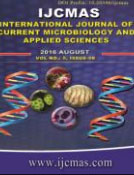


 National Academy of Agricultural Sciences (NAAS)
National Academy of Agricultural Sciences (NAAS)

|
PRINT ISSN : 2319-7692
Online ISSN : 2319-7706 Issues : 12 per year Publisher : Excellent Publishers Email : editorijcmas@gmail.com / submit@ijcmas.com Editor-in-chief: Dr.M.Prakash Index Copernicus ICV 2018: 95.39 NAAS RATING 2020: 5.38 |
An increasing incidence of Group B Streptococcus (GBS) infection in non-pregnant women has been noted in recent years and its early diagnosis remains difficult, since symptoms are very nonspecific, its frequency has not been completely investigated in urinary tract and vaginal infections in non-pregnant women. The aim of this study to investigate the role of GBS in urinary and vaginal infections in non-pregnant adults from outpatients Healthcare Center and their antimicrobial susceptibility profiles. Also, to assess the Macrolide-inducible resistance to Clindamycin. A total of 46 GBS isolates were investigated; 28 urine and 19 HVS samples. The samples were processed by wet smear, direct gram, culture, identification by catalase, serotyping and VITEK 2 Compact and finally the susceptibility and inducible Clindamycin resistance by VITEK 2 Compact. We detected 3.8% and 9.5% GBS in the urine and HVS samples respectively. Most of UTI samples were in October and November (25%, 21.4%) respectively, however HVS samples were highest in June (21%). Both UTI and vaginal infections were common in autumn (50%, 36.8%) respectively. We found that 75% of UTI samples had high colony count (>105/CFU) and low WBCs. We detected 13/15 (86.7%) urine samples and 10/13 (76.9%) HVS samples which were Erythromycin resistance and inducible clindamycin resistance positive with highly statistically difference (P=0.00). GBS was highly susceptible to Ampicillin, Benzyl Penicillin, Cefotaxime, Ceftriaxone, Linezolid, TMP/SMZ and Vancomycin. Levofloxacin showed good susceptibility (82.1%, 78.9%) for UTI and vaginal infections respectively. However Erythromycin and Clindamycin showed moderate resistance for urinary and vaginal infections (53.6%, 68.4%) for Erythromycin and (57.1%, 63.2%) for Clindamycin respectively. Tetracycline showed very high resistance rate (96.4%, 94.7%) for urinary and vaginal infections respectively. Finally, the present study concluded that we must do culture if the patient complaining of manifestation of UTI even in presence of low WBCs count (absence of pyuria). Physicians can start empirically with Penicillin or Ampicillin for GBS but in case of allergy to Penicillin, we must do the antibiotic susceptibility due to the high resistance rate to Clindamycin and Erythromycin nowadays.
 |
 |
 |
 |
 |